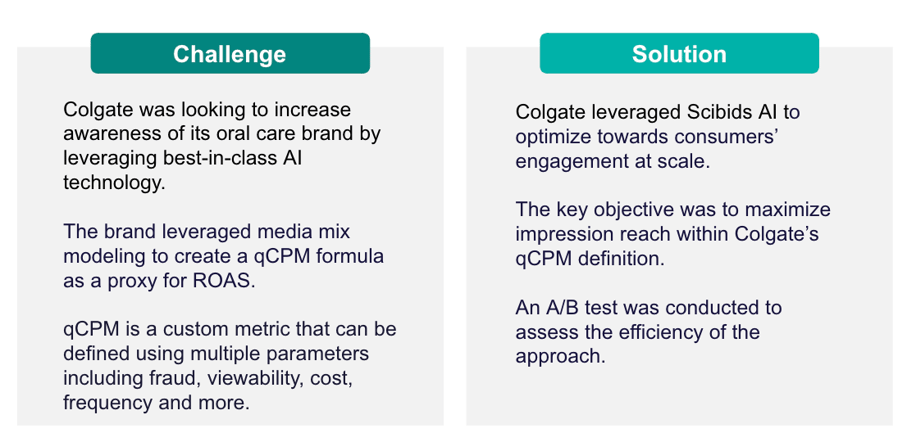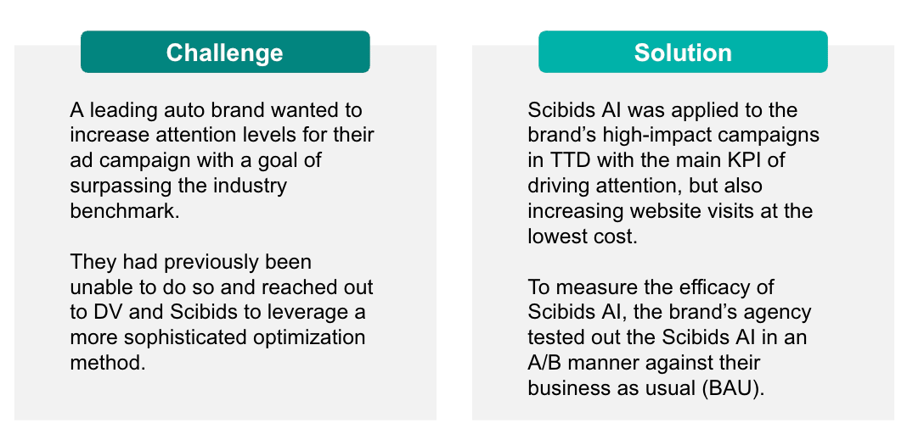AI is reshaping the world and pushing digital advertising boundaries by offering unprecedented innovations and efficiencies across the industry.
Artificial intelligence (AI) has revolutionized a variety of industries and is redefining the meaning of success. The digital ad space is no exception — according to DV data, 56 percent of marketers plan to use AI-powered data analysis tools over the next year. As advertisers strive to optimize efficiencies and improve business outcomes, AI technology offers innovative solutions to enhance campaign performance.

Below, we’ll discuss some of the ways AI is reshaping the digital advertising ecosystem, including how custom bidding strategies that leverage AI-driven algorithms can maximize marketing efforts and yield positive results.
AI in Advertising: How Do Marketers Use It?
AI’s evolution is impacting the digital marketing landscape, from media buying to content consumption. Over the past year, the industry has witnessed the widespread adoption of AI by multiple advertising stakeholders. Before diving into AI’s role in advertising, though, it’s important to first have a basic understanding of how AI impacts our everyday lives.
What Is Artificial Intelligence?
AI is the simulation of human intelligence in machines, designed to mimic cognitive functions and make independent decisions based on the analysis of large data sets. Think of AI as the umbrella term for any type of digital application that can perform a function without manual guidance.
Within the AI umbrella, we find:

Machine learning is when a machine can make independent decisions based on human-guided algorithms. Machine learning requires human oversight to correct mistakes, but performance improves over time with exposure to more data.
Deep learning, however, is when a machine decides what’s right and wrong based on its own deep neural networks. Humans don’t always know how deep learning machines reach particular conclusions.

Predictive AI uses machine and deep learning to predict the future and help improve outcomes. It does this by analyzing large data repositories that recognize historical data patterns across time to infer future trends or behaviors and better understand market trends.
Generative AI uses machine and deep learning to create images, text, video and software code based on user prompts. It doesn’t rely on prior data inputs and can produce novel results.

Whether we realize it or not, AI is embedded in many aspects of our daily lives, such as smart home devices, customer service chatbots or video and music recommendations.
AI also makes jobs easier and more efficient. It automates repetitive tasks, allowing employees to focus on more strategic and creative aspects of their roles. This can include data entry, scheduling and responding to customer inquiries with remarkable speed and accuracy. This not only increases productivity but also reduces the potential for human error. In the end-to-end supply chain industry, for example, AI helps to implement automated systems, such as robots that process and pick items from fulfillment centers once a consumer places an order. Overall, AI is a powerful ally, streamlining operations and unlocking new opportunities for innovation.
So How Is AI Used in Advertising?
In advertising, marketers use AI to analyze vast amounts of data, predict consumer behavior and optimize advertising campaigns. This transformative technology allows advertisers to reach desired audiences, maintain brand safety and maximize digital campaign ROI.
Not only do AI-powered advertiser tools have the ability to optimize bidding strategies and campaign management with unparalleled precision, but they also play a major part in offering measurement services like brand suitability and fraud protection. Natural language processing and predictive analytics are also examples of AI tools that give brands access to advanced data insights and empower them to make important business decisions.
Below are examples of how marketers can maximize protection and improve campaign outcomes with the help of AI advertiser tools.
AI Powers Content Classification
Universal Content Intelligence is a classification engine that powers expansive content categorization across web, mobile, CTV and social environments. It leverages robust policy definitions and leading AI technology to provide advertisers with the most accurate classification that analyzes content across all key components, including:
-
Visual Element Analysis: Leveraging Computer Vision models and Optical Character Recognition, it identifies objects and people within the content.
-
Audio and Speech Analysis: It analyzes audio elements, including video dialogue and music.
-
Text Analysis: It classifies text, captions, transcriptions, links and metadata leveraging Natural Language Processing methods.
This meticulous AI-powered analysis ensures that the visual, audio, speech and text components surrounding your ads are both suitable and consistent with your brand’s message and resonate with your audience.
AI Fights Ad Fraud
Generative AI has made it very easy to commit ad fraud by allowing fraudsters to falsify data patterns and create advanced schemes that exploit digital advertising systems. Advertisers are aware of this threat — DV data indicates that 58 percent of marketers say AI-powered bot fraud schemes are disrupting the digital ecosystem. But AI tools can also help combat fraudulent activities.
AI-powered technologies, techniques and analytical tools can uncover some of the most sophisticated fraud schemes in the industry. Analyzing over two billion impressions per day, the DV Fraud Lab uses advanced analytics and machine learning models to identify and analyze data anomalies, indications of potentially falsified traffic and fraudulent activity. Nearly half of marketers plan to use AI-powered ad fraud detection over the next year, according to DV data.
AI Drives Significant ROI
While it has a wide range of potential applications within digital advertising, AI may have the most significant and positive impact on media buying. Through its ability to customize bidding algorithms, AI technology can drive programmatic campaigns toward achieving the results that matter most.
Maximize Advertiser Outcomes with Custom Bidding Algorithms
More brands are adopting the use of AI-powered advertiser tools — such as custom bidding algorithms — to reduce their manual lift and enhance operations. In fact, DV data shows that 33 percent of marketers plan to use custom bidding algorithms in their advertising strategy over the next year.
What Are Custom Bidding Algorithms?
Custom bidding algorithms are designed to improve campaign delivery based on specific business goals. Unlike standard bidding strategies, custom algorithms consider multiple factors in order to optimize against multiple KPIs simultaneously. By cutting down manual transactions, advertisers can save time and bid more effectively on ad placements, improving performance and reducing media waste.
Implementing an effective custom bidding strategy requires clearly understanding your business goals, target audience and available data. Below are some steps marketers can take to develop a solid custom bidding strategy.
Steps Marketers Can Take to Develop a Solid Custom Bidding Strategy
Step 1: Define objectives. Clearly outline your business goals. Do you want to maximize conversions or achieve a specific ROI? Defining goals will allow you to determine appropriate KPIs for your campaign.
Step 2: Analyze and leverage data. Use data sets most relevant to your campaign — such as proprietary first-party data, historical performance metrics and more — to identify trends and patterns. Which keywords or placements have driven the most conversions or engagements in the past? This critical information will inform your custom bidding algorithm.
Step 3: Segment audiences. Divide your audience into smaller, more specific segments based on behavior, demographics and other relevant characteristics.
Step 4: Test and optimize. Test different bidding strategies to see what works best by comparing performance of various bid adjustments. Continuously monitor the results and make data-driven adjustments.
By following these steps, advertisers can develop a robust custom bidding strategy that maximizes your ROI and drives better campaign performance.
Scibids AI Custom Bidding Use Cases
Advertisers that have large amounts of proprietary first-party data typically employ teams of analytics experts to determine how that information informs their sales, inventory and customer interactions. But this valuable data is wasted when it’s not being used in their media buying process. Using this data to its full potential requires going beyond basic performance KPIs.
Scibids AI provides the resources necessary to build AI-powered algorithms and take advantage of custom bidding features within DSPs, awakening the potential to achieve unique business objectives. With Scibids AI, you can:
-
Choose the best data signals. Scibids AI is compatible with a variety of data signals, including first-party data, offline sales data, attention metrics and more.
-
Go beyond basic performance KPIs. Scibids AI allows you to exceed one-size-fits-all metrics and gain the flexibility to establish custom KPIs.
-
Optimize toward multiple campaign outcomes. Manage competing campaign priorities, such as performance and cost efficiency, across leading DSPs, including DV360, TTD, Xandr and more.
Getting started with Scibids AI technology is a straightforward process and yields positive results. Below, we’ve outlined a few Scibids AI custom bidding use cases.
Scibids AI Use Case #1: Maximize Campaign Reach on Quality Media Inventory
Colgate Increased Quality Reach by 92% With Scibids AI


Scibids AI Use Case #2: Augment ROAS Campaign Objectives
Scibids Boosts ROAS for Barcelo Across Spain and the U.S.


Scibids AI Use Case #3: Enhance Attention Campaign Objectives
Global Auto Brand Increases Attention with Scibids AI


Implement AI Into Your Campaign Strategy Today
AI in advertising offers powerful solutions that enhance customer experiences, optimize ad spend and improve campaign performance. By implementing AI tools and leveraging data-driven insights, marketers can navigate the new digital age with confidence and success.
Learn more about how you can implement AI into your media buying strategy by downloading An Advertiser’s Guide to Dynamic AI Activation.





